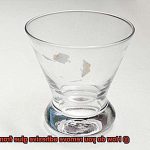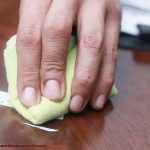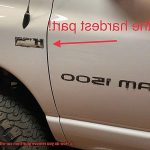Remember that dreaded moment when glue decided to wreak havoc on your favorite shirt or brand-new laptop? We’ve all been there, desperately searching for a solution to banish those stubborn sticky messes without causing any harm.
Well, fear no more. In this blog post, we’re going to spill the beans on how to successfully remove different types of glue. Whether you’re dealing with super glue’s iron grip, hot glue’s sneaky residue, or even those pesky sticker remnants, we’ve got your back with tried and tested methods that’ll have you living a life free from the clutches of adhesive chaos.
So gather ’round, my fellow victims of sticky disasters. It’s time to dive headfirst into the wild world of glue removal. But hold up – did you know that not all glues are created equal? That’s right. Each type demands its own unique approach for effective elimination.
Throughout this post, we’ll introduce you to an incredible lineup of household heroes and cleaning champions that possess the magical power to dissolve and conquer these adhesive challenges. From vinegar and baking soda to nail polish remover and rubbing alcohol – prepare to be amazed by the arsenal of readily available solutions at your fingertips.
But wait, there’s more. We won’t leave you hanging when it comes to specific surfaces either. Whether it’s rescuing delicate fabrics or salvaging wooden masterpieces, we’ve got expert tips tailored just for you.
So buckle up, dear readers. Bid farewell to endless frustration and get ready to conquer even the stickiest situations with our invaluable guide on removing different types of glue. Say goodbye to sticky nightmares and embrace a world where glue is nothing but a distant memory.
What is Glue?
Contents
Prepare to be captivated by the extraordinary world of glue, a versatile substance that holds our world together. From joining pieces of wood to fixing broken objects, glue is an essential tool in countless industries and everyday applications. In this captivating guide, we will delve into the different types of glue, their unique properties, and the art of removing them effectively.
Super Glue: The Mighty Bonding Power
Super Glue, also known as cyanoacrylate, possesses an unparalleled bonding strength. Its secret lies in its ability to create a molecular attraction between surfaces, forming an unbreakable bond. When faced with the challenge of removing super glue, reach for acetone-soaked cotton balls or cloths and gently rub away the adhesive. Exercise caution when working with delicate surfaces to avoid unintended damage.
Wood Glue: Building Solid Foundations
Wood glue is the backbone of woodworking projects, boasting exceptional adhesion properties. To remove dried wood glue, begin by scraping off as much residue as possible using a scraper or putty knife. Then, employ the power of warm water by applying a damp cloth to the remaining glue and gently scrubbing with a soft-bristled brush or cloth.
Epoxy Glue: Unyielding Strength with a Delicate Touch
Epoxy glue is a formidable adhesive that demands special attention during removal. Soften hardened epoxy by subjecting it to heat from a hairdryer or heat gun. Once pliable, carefully scrape away the epoxy using a plastic scraper or putty knife. For any stubborn remnants, enlist the assistance of acetone on a cloth for gentle yet effective removal.
Fabric Glue: Mending Mishaps with Finesse
When fabric glue mishaps occur, swift action is key to successful resolution. Begin by blotting excess glue with a clean cloth or paper towel, taking care not to spread the adhesive further. Next, apply rubbing alcohol to a cotton ball and delicately dab the affected area to loosen the fabric glue. Finally, scrape off the adhesive using a blunt knife or your trusty fingernail.
Different Types of Glue and Their Characteristics
Glue is a versatile adhesive that is used for various purposes, such as arts and crafts, woodworking, and household repairs. There are different types of glue available in the market, each with its own unique characteristics and properties. Understanding these characteristics is essential in determining the most effective way to remove glue from different surfaces. In this article, we will delve into the world of glue and explore the characteristics and removal methods of five common types: super glue, wood glue, epoxy glue, fabric glue, and hot glue.
Super Glue: Breaking Bonds with Acetone
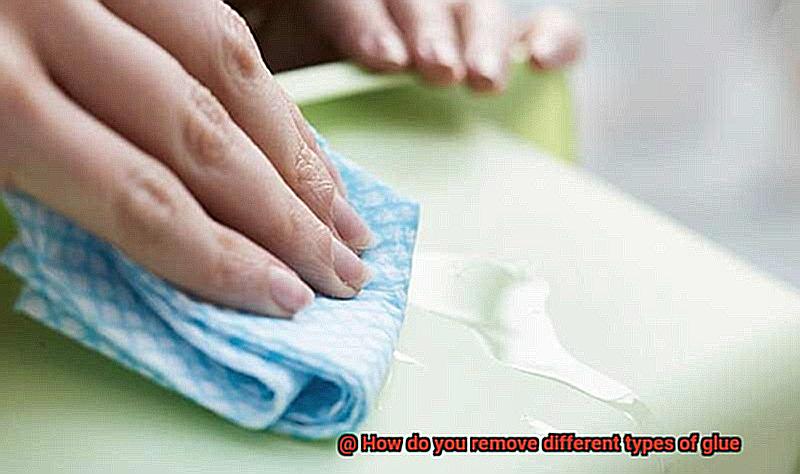
Super glue, also known as cyanoacrylate adhesive, is famous for its fast-drying and strong bonding properties. It forms an instant bond between surfaces and is often used for quick repairs or bonding materials like metal, plastic, and ceramics. Removing super glue can be a bit trickier than removing other glues due to its strong adhesive properties. One effective method is using acetone or nail polish remover containing acetone to break down the bond of super glue. However, caution must be exercised when using acetone on certain surfaces as it may cause damage or discoloration.
Wood Glue: Peeling Away Stickiness with Patience
Wood glue is specifically formulated for bonding wood surfaces. It provides a strong bond and dries clear. If you find yourself with unwanted wood glue on a surface, fear not. Start by gently scraping away as much of the dried glue as possible using a scraper or putty knife. Then, dampen a cloth with warm water and apply it to the remaining glue residue. Allow the water to soak in for a few minutes before using a soft brush or cloth to gently scrub away the remaining glue. With patience and perseverance, your wood will be free from unwanted stickiness.
Epoxy Glue: Softening the Bond with Heat
Epoxy adhesive is a popular glue used in construction, automotive repairs, and industrial applications. It consists of two components – a resin and a hardener – that create a strong and durable bond resistant to heat, water, and chemicals. Removing epoxy glue can be challenging, especially if it has fully cured. However, using heat to soften the glue is an effective method. You can use a heat gun or hairdryer to gently warm the epoxy, making it easier to peel or scrape off. Additionally, rubbing alcohol or acetone can help dissolve any leftover epoxy residue.
Super Glue Removal Techniques
Super glue, also known as cyanoacrylate adhesive, is renowned for its quick bonding and formidable strength. But fear not, for I have gathered a collection of tried-and-tested methods to conquer this sticky situation.
First and foremost, let’s talk about the classic contender: acetone. This magical substance can be found in nail polish removers and has the power to dissolve super glue, making it easier to remove. But before you go charging in, heed my warning. Acetone can be a double-edged sword, as it has the potential to damage certain materials like plastics or painted surfaces. So, it’s wise to test a small inconspicuous area first and proceed with caution.
If you’re looking for a gentler approach, warm soapy water is your trusted ally. Immerse the affected area in this comforting elixir to loosen the bond of the super glue. Once sufficiently soaked, wield a soft brush or cloth and gently scrub away the remnants of the adhesive. It’s as easy as pie.
Now, let’s tackle those delicate surfaces such as fabrics or leather. Enter rubbing alcohol, your knight in shining armor. Apply a small amount onto a cloth and carefully dab at the glue until it begins to dissolve. But wait. Don’t forget to test the alcohol on an inconspicuous area first, ensuring it won’t cause any unwanted harm.
But what if you face an unwavering super glue stronghold? Fear not, for freezing is here to save the day. Yes, freezing the adhesive can render it brittle and easily removable. Employ some ice cubes or a cold pack and apply their icy touch to the glued area. Allow them a few minutes to work their magic until the glue becomes hard and fragile. Then, with precision and finesse, scrape away the frozen glue using a plastic scraper or even your trusty fingernail.
Should all else fail and the super glue persists, take solace in the fact that there are commercial adhesive removers specially crafted for this very purpose. These potent concoctions are armed with chemicals that skillfully dismantle the bond of super glue without causing any damage to the surface. Simply follow the instructions on the bottle, and bid farewell to that pesky adhesive in no time.
Wood Glue Removal Techniques
Fear not. As an expert in wood glue removal techniques, I’ve curated a collection of tried-and-true methods to help you tackle this sticky situation. From harnessing the power of heat and solvents to unlocking the magic of vinegar and sanding, we’ve got all the secrets you need.
Harnessing the Power of Heat:
When it comes to effortlessly removing wood glue, heat is your secret weapon. By applying heat to the glue, you can soften it, making it a breeze to scrape off. Grab your trusty heat gun or hairdryer set on high heat and hold it a few inches away from the glue. Move it in gentle, circular motions to evenly distribute the heat. As the glue begins to soften, delicately scrape it away using a putty knife or scraper. Remember, a gentle touch ensures that your precious wood surface remains unscathed.
Unleashing Solvent Solutions:
For those who prefer a chemical approach, solvents are your invaluable allies in the fight against wood glue. Acetone, commonly found in nail polish remover, is a potent solvent that can dissolve or weaken wood glue’s adhesive properties. Dab a small amount of acetone onto a clean cloth and gently rub it over the affected area. Allow the solvent to work its magic for a few minutes before employing a scraper or toothbrush to remove the softened glue. Always prioritize safety by working in a well-ventilated space and donning protective gloves.
The Wonders of Vinegar:
Nature’s remedy for wood glue mishaps comes in the form of humble vinegar. Thanks to its acidic properties, vinegar can break down the adhesive bonds of wood glue with ease. Create a powerful solution by mixing equal parts vinegar and water in a convenient spray bottle. Spritz the solution onto the affected area and let it sit for a few minutes. Armed with a trusty scraper or toothbrush, gently remove the softened glue. Remember to rinse the area with water once the glue is gone to neutralize the acidity of the vinegar.
Epoxy Glue Removal Techniques
Epoxy glue, with its remarkable strength and versatility, is a go-to adhesive for countless applications. But what happens when you need to bid farewell to its stubborn grip? Fear not. As an expert in epoxy glue removal techniques, I’ve delved deep into the realm of adhesive liberation to equip you with the most powerful and enchanting methods. Get ready to discover the secrets behind harnessing the power of heat and solvents, embracing natural remedies, and unleashing the mechanical mastery of sanding.
The Power of Heat: Vanquishing Epoxy Glue’s Hold
When it comes to facing off against epoxy glue, heat becomes your trusty ally, melting away its unyielding grip. Here’s how you can wield this power:
- Equip yourself with a heat gun or hairdryer set on its highest setting.
- Hold the heat source a few inches away from the epoxy glue, effortlessly flicking it back and forth.
- As the glue succumbs to the intense heat, it transforms into a pliable state, allowing you to deftly scrape it off using a putty knife or plastic scraper.
Solvents: Unlocking the Sorcery of Epoxy Glue Removal
Solvents emerge as another potent weapon in your arsenal against epoxy glue, dissolving its bonds with ease. Here’s what you need to know:
- Acetone stands as a commonly used solvent, yet caution must be exercised when dealing with delicate surfaces.
- Apply a small amount of acetone onto a clean cloth, gently coaxing the epoxy glue into submission as it softens under your touch.
- Wipe away the adhesive using the cloth, ensuring you work in a well-ventilated area while donning protective gloves.
Embracing Natural Remedies: Nature’s Magic against Epoxy Glue
For those who seek a more natural approach, vinegar and citrus-based cleaners weave their enchanting powers to break down epoxy glue. Follow these steps to unleash their magic:
Fabric Glue Removal Techniques
Fabric glue may be a crafter’s best friend, but when it ventures into unintended territories or causes an unsightly mess, it’s time to take action. As a seasoned expert in fabric glue removal techniques, I’m here to share my secrets for effectively banishing those sticky situations without compromising the integrity of your beloved fabrics. Prepare to bid farewell to fabric glue mishaps as we delve into the art of successful removal.
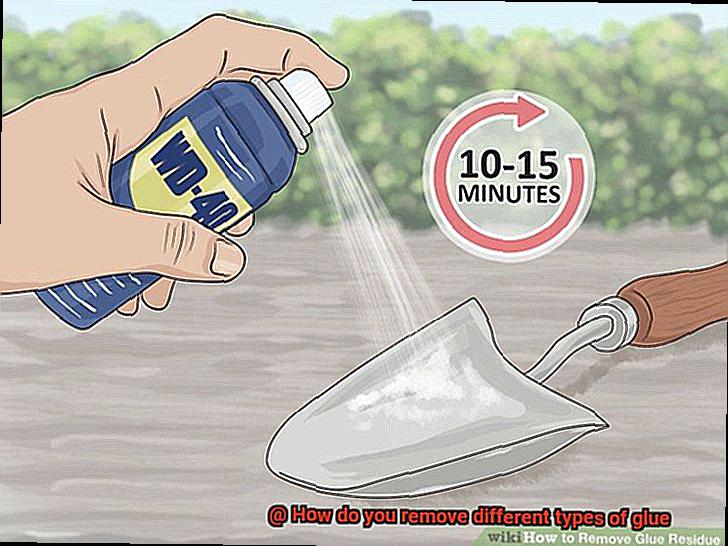
Harness the Power of Heat:
Harnessing the power of heat is a tried and true method for fabric glue removal. By gently applying heat, you can soften the adhesive and make it a breeze to scrape off. Here’s how you can do it:
- Set your iron to a low heat setting.
- Place a clean cloth over the glued area.
- Glide the iron over the cloth for a few seconds.
- Utilize a plastic spatula or your fingernail to delicately scrape off the softened glue.
- Exercise caution with delicate fabrics, ensuring not to subject them to excessive heat that could cause damage.
Ace It with Acetone or Nail Polish Remover:
When dealing with stubborn fabric glue, acetone or nail polish remover can be your secret weapon. However, it’s essential to perform a patch test on an inconspicuous area of the fabric first, safeguarding against any potential discoloration or damage. Follow these steps to remove fabric glue using acetone:
- Soak a cotton ball or swab in acetone.
- Gently dab the soaked cotton onto the glued area.
- Allow the acetone to work its magic for a few minutes, dissolving the adhesive.
- Employ a plastic spatula or your fingernail to softly scrape away the loosened glue.
Gentle Alcohols for Delicate Fabrics:
For delicate fabrics that demand a more gentle touch, rubbing alcohol or isopropyl alcohol can be your saving grace. These alcohols possess adhesive-dissolving properties that effectively tackle fabric glue. Follow these steps for a delicate alcohol-based removal:
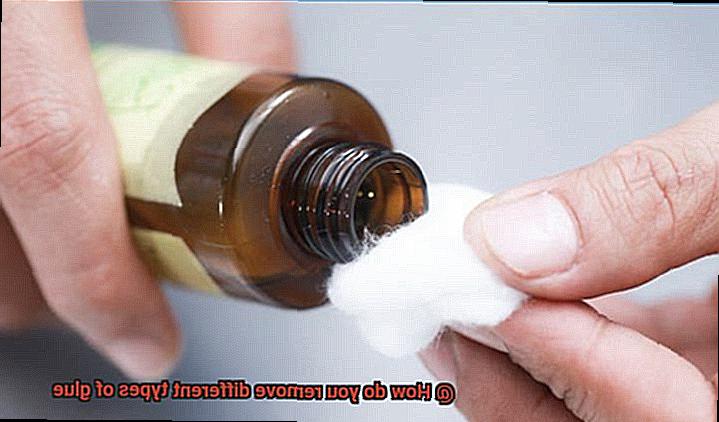
Hot Glue Removal Techniques
Hot Glue Removal Techniques: Say Goodbye to Sticky Situations.
Hot glue, also known as hot melt adhesive, is a handy tool in any crafting enthusiast’s arsenal. But let’s face it – we’ve all had those moments when we accidentally get hot glue where it’s not supposed to be. Whether it’s on fabric, glass, or any delicate surface, removing hot glue can be quite the challenge. But fear not. As an expert in hot glue removal techniques, I’ve got you covered. Let’s dive into the secrets of successfully banishing that sticky situation without compromising your beloved materials.
The Power of Heat:
Heat is a superhero when it comes to removing hot glue. Enter the trusty hairdryer, your sidekick in this mission. Set it to its hottest setting and hold it a few inches away from the glued area. Direct the hot air towards the glue and watch as it softens, making it easier to peel off with your fingers or a plastic scraper. Just remember to handle with care and avoid burning yourself.
No hairdryer? No problem. Your iron is ready to step in as the hero of heat-based hot glue removal. Set it to a low or medium heat setting (depending on the fabric) and place a thin cloth over the affected area. Press the iron gently on top of the cloth for a few seconds, allowing the heat to transfer onto the glue. Lift the cloth and check if the glue has softened. If so, quickly scrape it off with a plastic scraper or your trusty fingernail.
Freezing:
When it comes to small amounts of hot glue on hard surfaces like glass or metal, freezing can work wonders. It’s like putting that sticky villain on ice. Grab some ice cubes or an ice pack and place them on top of the glued area for several minutes. The extreme cold temperature causes the glue to harden and become brittle, making it easier to chip away at it with a plastic scraper or your fingernail. Remember, avoid using sharp tools that may scratch or damage the surface – we want a clean victory here.
Safety Precautions When Removing Different Types of Glues
Removing different types of glues can be a challenging task, but it is crucial to prioritize safety to prevent accidents and injuries. In this article, we will delve into the essential safety precautions that should be taken when removing various types of glues.
Prioritize Safety Gear:
Before embarking on the glue removal process, it is vital to equip yourself with the necessary safety gear. Ensure you wear protective gloves, safety goggles, and a face mask to shield yourself from potential harm. By donning these protective items, you can safeguard your skin, eyes, and respiratory system from any chemical exposure.
Ventilation Is Key:
Proper ventilation is of utmost importance when working with adhesive removers or solvents. Make sure you carry out the glue removal in a well-ventilated area or utilize fans and open windows to facilitate sufficient air circulation. This precaution prevents the inhalation of harmful fumes and helps maintain a safe working environment.
Follow Instructions Diligently:
To ensure your safety and achieve optimal glue removal results, it is essential to carefully read and adhere to the instructions provided on the adhesive remover or solvent packaging. Each product may have specific safety guidelines that need to be followed. By following these instructions meticulously, you can mitigate risks and effectively remove the glue.
Handle Flammable Products with Caution:
Some adhesive removers or solvents are highly flammable, making it crucial to exercise caution when using them. Steer clear of open flames, sparks, or any potential ignition sources while handling these products. Additionally, store them in cool, dry areas away from heat sources to minimize the risk of accidents.
Shield Yourself from Contact:
During the glue removal process, it is important to minimize direct contact between adhesive removers or solvents and your skin. Certain products can cause skin irritation or trigger allergic reactions. If contact does occur, promptly wash the affected area with soap and water to minimize any potential harm.
Proper Disposal:
After completing the glue removal process, it is crucial to dispose of any leftover adhesive remover or solvent appropriately. Follow local regulations and guidelines for proper disposal methods. Avoid pouring them down drains or disposing of them in regular trash bins as they may be classified as hazardous waste.
siPYDOFVLSI” >



